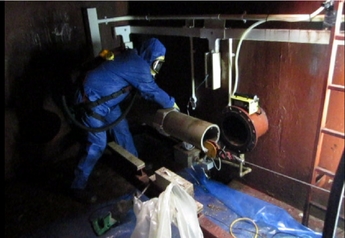A major project to decommission redundant active drains on the Harwell site has been successfully achieved with significant time and cost savings, thanks to a new approach that slashed the project duration to less than a third of the originally anticipated timescale, parent body organisation Babcock reports.

Decommissioning of the redundant New Main Active Drain (NMAD) system – commissioned in 1987 to carry low level liquid effluent from the major facilities on the site to the Liquid Effluent Treatment Plant (LETP) – began on site in May 2011 and has now been completed, just seven months later. The original estimated three-year timescale for the project has been significantly reduced thanks to a novel approach developed by Babcock-owned site licensee company RSRL.
The 4000 metre-long drain system extended across the site and included a series of delay tanks and 55 manhole access chambers. The drain line itself consisted of a double pipe – an outer one of bitumen-coated cast iron, with an inner pipe of polypropylene. The inner pipe had no joints except within the chambers, to minimise the chance of leakage or trapped radioactivity, while the outer pipe provided back-up containment should a leak occur.
When the system was built it was assumed that decommissioning would reverse the construction process, involving access ramps being dug and the pipe brought out and cut up on the surface. Instead, the solution developed after considerable consultation and investigation involved gaining access to the chambers and feeding the inner pipe out in 0.9 metre sections (determined by the dimensions of the underground chamber) to be cut up underground using a reciprocating saw with protection to catch any contamination or spillage, leaving the drain system’s outer pipe and access chambers in situ (having been proven to be uncontaminated).
The new method has meant completing many thousands of cutting operations underground, but practical measures were developed to do this. These included confined space entry arrangements, working in respiratory protective and personal protective equipment throughout, using radiological-controlled areas and systems underground to control contamination spread, and ensuring the process was well-rehearsed.

Working underground for long periods in full protective gear in a cramped working space under radiological control conditions safely was a significant challenge, but was successfully achieved. The approach was found to be considerably quicker and more efficient, and therefore more cost-effective, as a result of avoiding the need for access trench excavation (which would have been slow), which also minimised potential disruption to underground services.
Further savings were achieved by recycling specialist health physics drain probe equipment, originally designed and built over five years ago at sister RSRL site Winfrith, for use in demonstrating that the NMAD outer pipe and chambers, left underground, are uncontaminated and pose no liability to people or the environment. The so-called dRover probe (which can crawl down the pipe taking measurements and sending back images to check for fractures, breaks, obstructions and so on) was refurbished and re-commissioned by the Harwell team.
“The new approach to the project, and re-cycling of existing equipment from Winfrith, has enabled us to provide our customer, the NDA, with optimum value thanks to the considerable time and cost savings achieved,” RSRL Managing Director Alan Neal said.
Related ArticlesL3-MAPPS to supply classroom simulators for South Texas Plant modifications affect simulator upgrades in Switzerland and Slovakia




